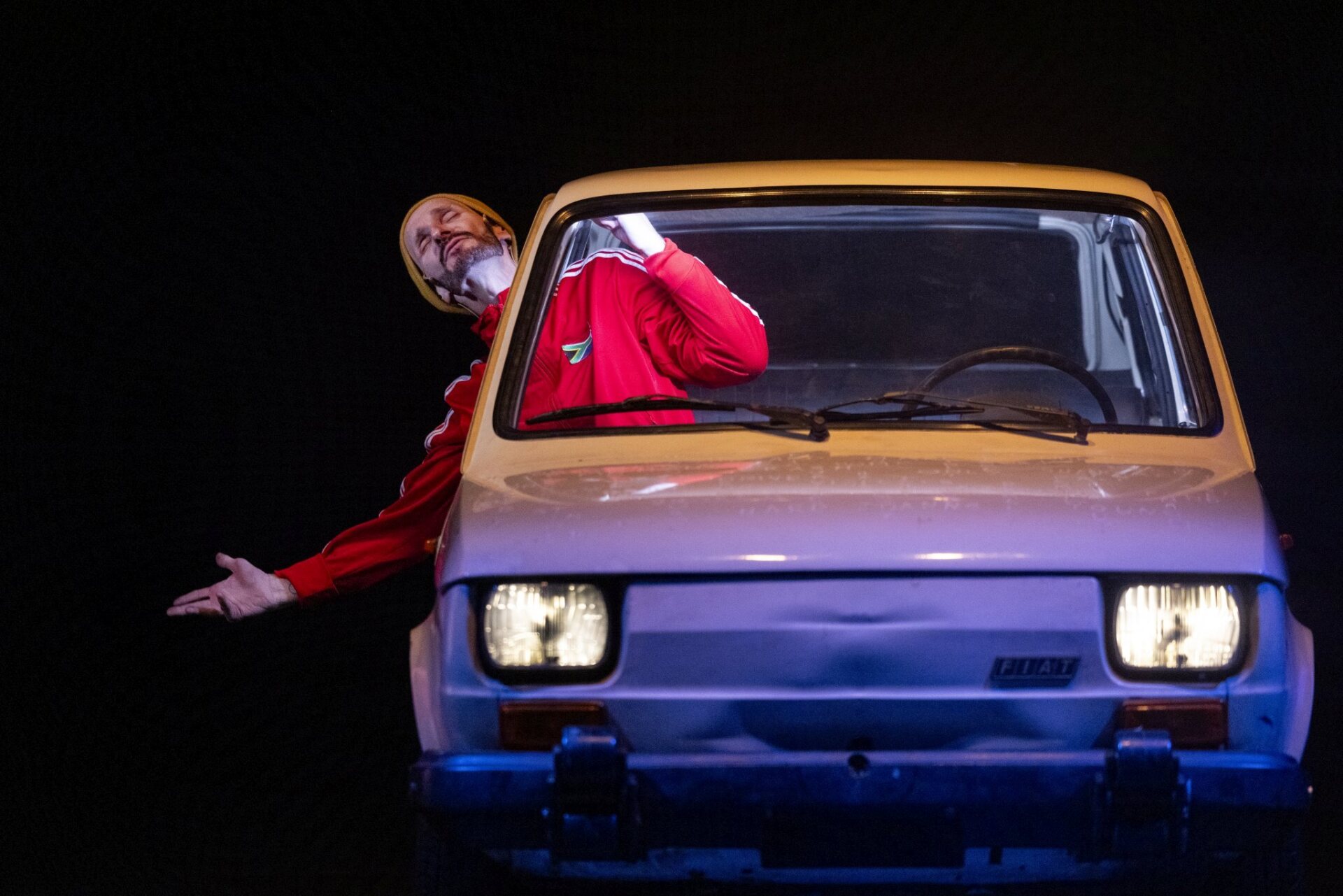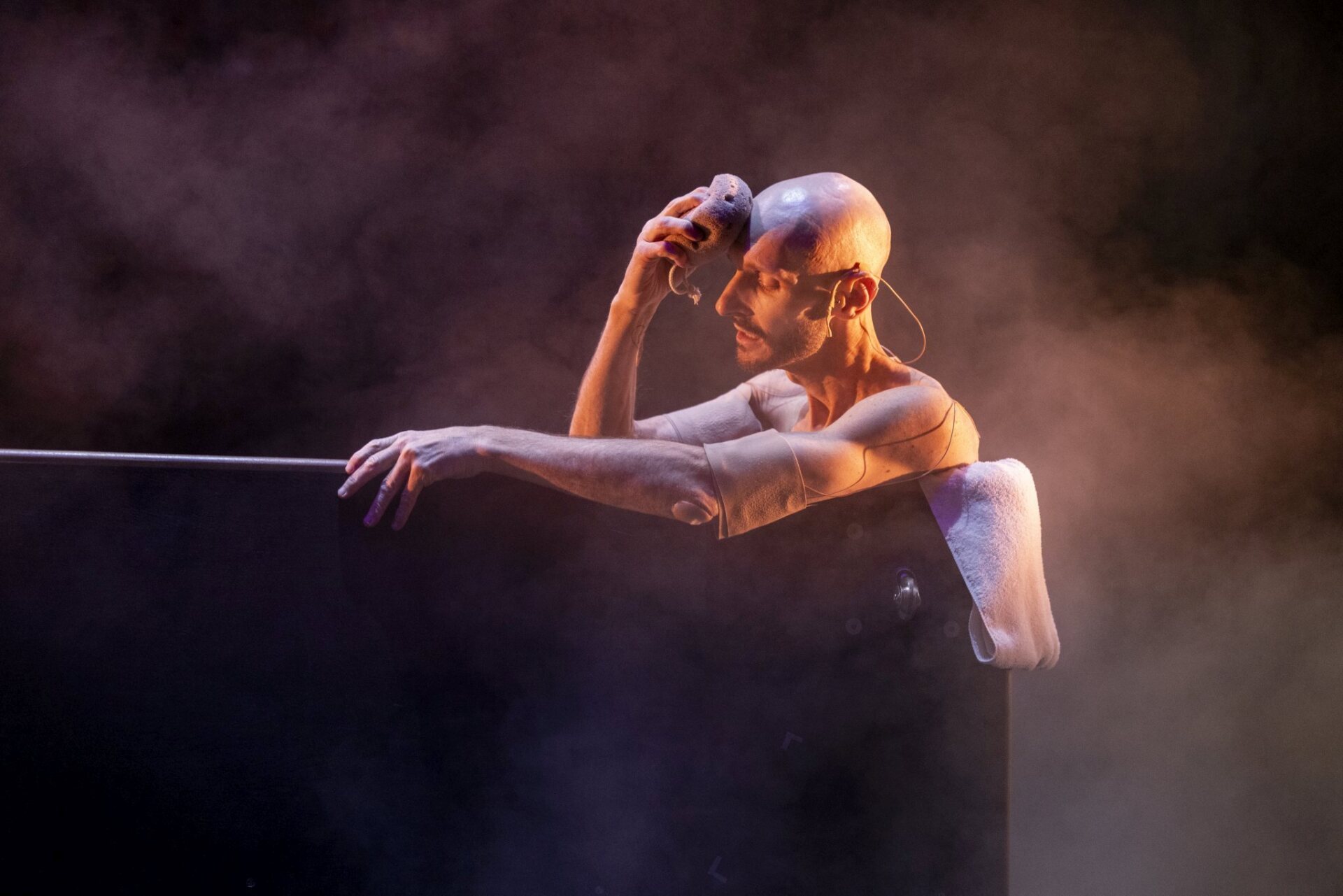”An Accident / A Life” is an autobiographical solo performance by Australian artist, director, choreographer, and dancer Marc Brew, in collaboration with Belgian choreographer Sidi Larbi Cherkaoui. The two first met in 2021, during the COVID-19 pandemic, through a Zoom meeting. Originally intended as a film due to the restrictions of the pandemic, the work has transitioned to the theater stage and, in 2024, became part of the NO LIMITS festival.
However, the film as an element has never completely left the performance. This work is a combination of theater, film, dance, and music. The performance is brought to life by a camera, a car, and Marc Brew as performer. When the curtains open, we see a car on stage with Marc Brew lying in front of it. Soon a camera with a line descends from above and two men enter the stage. They are in charge of the camera, moving it in and out of the performance as if they were recording a film. To the left and right side of the stage, two screens show what the camera is recording, with German subtitles for the audience.
Marc gets into a car and starts to tell how it all began. The whole performance is a story that shows a journey. It is the autobiographical story of the accident that changed his life. He often says things like “um” and “you know,” which makes it feel more casual and relatable. Besides words, he uses his body to communicate with us. The camera often gets very close to Marc’s face and hands, allowing us to see his veins and the raw exposure of his body. This intimacy helps the audience to connect even more deeply with the performer.

He is wearing a red jacket with the flag of South Africa on it, the place where the accident happened. Marc spent months in a hospital in South Africa and often talks about how much he misses Australia and wants to go back, but can’t because he still has to stay in the hospital. There is a scene in which the setting is modelled to look like South Africa and the song “Africa” by Toto is playing. We see a coffin and flowers, Marc lies down in the coffin and covers himself with a white sheet so that the audience might think he has died. After the sheet is removed, Marc sits in a black suit with a skeleton design. Some famous lines from well-known songs begin to play, such as “Thriller” by Michael Jackson, “Bohemian Rhapsody” by Queen, “The Sound of Silence” by Disturbed, and others. The music stops when Marc says the famous line from Hamlet: “To be or not to be, that is the question.”

I think this was the transformative scene in the performance. After that, we see Marc dressed in a nurse’s costume operating on a heart. As he says, he has been “reborn.” He adapts to his new life, even though he faces many difficulties, and finds a new way to live. As the title of the performance suggests, it is not just an accident, but there is a life after.
Marc Brew was once a ballet dancer. One day he was in hospital and was paralysed from the neck down. The doctors told him he would never be able to walk again. But he knew that being a dancer was a part of his identity — his body was his instrument. So he defined a new idea of a dancer and believed that he could still express himself through movement and be a dancer.
I can’t help but mentioning the bathtub scene in which Marc lies behind the overturned sofa as if he were in a bathtub. He recalls being in the hospital waiting for a nurse but realising she wasn’t coming. At that moment, he asked his mum to give him a bath. As a twenty-year-old, he felt exposed and vulnerable asking his mom for help, but his mum was exactly who he needed at that moment. She was part of safety, love, and protection for him. In a moment of crisis or pain, it makes sense that he turns to her.
The mother-child relationship is a central theme in this performance. After the accident, Marc’s first thoughts were, “I couldn’t die; I need to tell my mom, because she’s going to worry.” I feel it’s significant that this theme was highlighted. As children we naturally look up to our mothers, but as adults many people lose that closeness or sometimes even contact with their parents. This performance portrays the deep emotional connection that doesn’t disappear with age. Even as an adult, Marc needed that feeling of unconditional support that only a mother can provide. By including this, he emphasises the importance of family ties and how such relationships can provide strength and comfort during the most difficult times in life.

HOW TO LIVE A LIFE
“How to live a life” is the last sentence of the performance, and I think that sums it up well. Marc Brew showed us how the human body is able to persevere, adapt, and find a way back to life. He showed how to use a disability as a strength — his fighting spirit never faltered, even when he had to find new ways to do things. Marc wanted to challenge himself with this performance, but I would say he also managed to challenge the audience. It’s up to each of us how we perceive an ending or a new beginning.